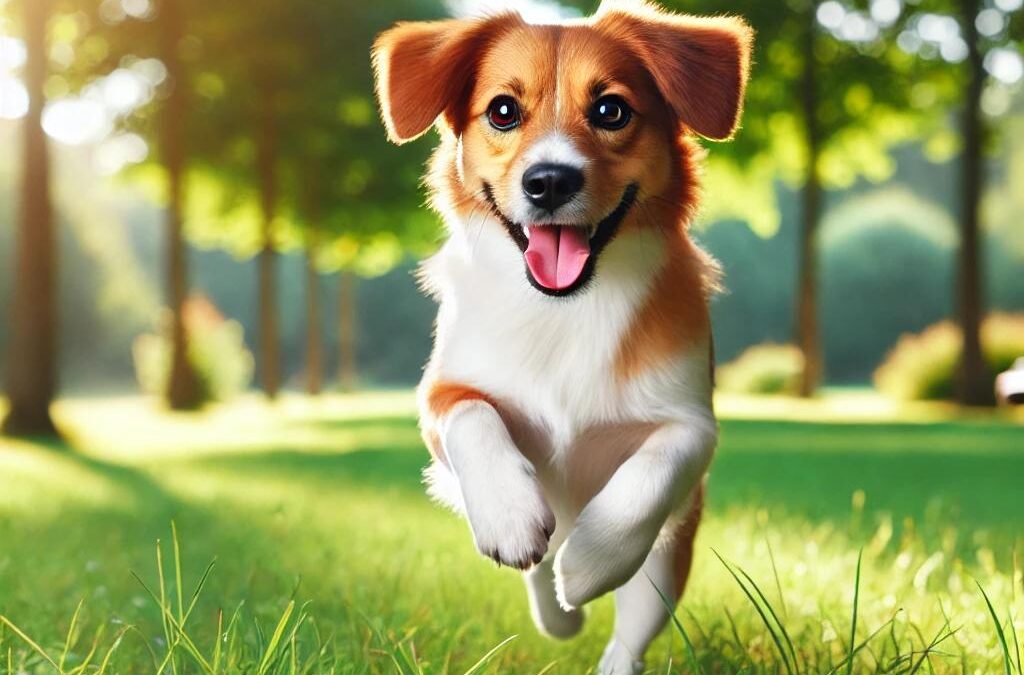
by TCMVET | Oct 12, 2024 | Dog Cancer & Tumors
Ruptured tumors in dogs, especially aggressive types like mast cell tumors, can be alarming for any pet owner. When a tumor bursts, it can lead to open wounds, bleeding, and an increased risk of infection. Understanding how to care for a dog with a ruptured tumor and knowing preventive measures can help avoid complications. In this article, we will discuss the common causes of tumor rupture, what immediate actions to take, and how to manage your dog’s long-term health.
Causes of Tumor Rupture in Dogs
Several factors can lead to a tumor bursting in dogs. Understanding these causes can help you minimize the risk:
- Physical Trauma
Dogs with tumors, particularly large ones, are more vulnerable to physical trauma. Simple activities like jumping, running, or rubbing against surfaces can cause the delicate tumor tissue to rupture.
- Tumor Ulceration
Certain types of cancer, like mast cell tumors and squamous cell carcinomas, often develop ulcerated surfaces as they grow. Ulceration weakens the outer layer of the tumor, making it more susceptible to bursting.
- Internal Pressure
As tumors grow, they sometimes cause internal pressure on nearby tissues and blood vessels. This pressure can weaken the tumor’s structure, eventually leading to a rupture.
Signs of a Ruptured Tumor
Recognizing the signs of a ruptured tumor can help you respond quickly and appropriately. Some common signs include:
- Bleeding or discharge from the tumor site
- Visible ulceration or an open wound
- Swelling and redness around the tumor
- Signs of pain or discomfort, such as whining or limping
If you observe any of these symptoms, it is important to provide immediate care and seek veterinary assistance as soon as possible.
Immediate Steps to Take When a Tumor Bursts
If your dog’s tumor ruptures, taking the right steps quickly can prevent infection and further complications. Here’s what to do:
- Clean the Wound
Use a sterile saline solution or clean water to gently clean the wound. Avoid using strong antiseptics like hydrogen peroxide or alcohol, as they can cause further irritation.
- Apply Gentle Pressure to Stop Bleeding
If the tumor is bleeding, apply gentle pressure using a sterile gauze pad or cloth to control the bleeding. Most minor bleeds should stop within a few minutes.
- Bandage the Wound
After cleaning the wound and controlling any bleeding, cover the area with a clean bandage to protect it from dirt and bacteria. Be sure to change the bandage regularly.
- Consult Your Veterinarian
Even if the bleeding stops, a burst tumor needs professional attention. Your vet will evaluate the wound, prescribe antibiotics if necessary, and recommend further treatments such as surgery or chemotherapy.
Long-Term Treatment and Prevention
After immediate care, long-term management is essential to ensure your dog’s health and prevent future ruptures. Depending on the type and stage of the tumor, your vet may recommend various treatments:
- Surgical Removal
If the tumor is localized, surgical removal is often the best option to prevent further growth or rupture. Surgery can also help eliminate the risk of infection from recurring open wounds.
- Chemotherapy or Radiation Therapy
For more aggressive cancers, chemotherapy or radiation therapy may be necessary to shrink the tumor and slow its spread. These treatments can help reduce the chance of future ruptures by decreasing the tumor’s size.
- Nutritional Support
A healthy diet rich in anti-inflammatory nutrients can play a supportive role in your dog’s recovery. Supplements like omega-3 fatty acids, turmeric, and medicinal mushrooms can help boost your dog’s immune system and promote healing.
- Traditional Chinese Medicine (TCM) for Supportive Care
Herbal therapies in Traditional Chinese Medicine (TCM) can complement conventional treatments and help support your dog’s recovery. Herbs like Szechuan lovage (Chuanxiong) can promote blood circulation and reduce swelling, while honeysuckle (Jin Yin Hua) can help alleviate inflammation and prevent infection. These natural remedies may help maintain your dog’s well-being during cancer treatments.
Preventing Future Tumor Ruptures
While not all tumor ruptures can be prevented, there are steps you can take to reduce the risk:
- Monitor Your Dog’s Tumor Regularly: Keep an eye on the size, texture, and appearance of the tumor. Report any changes to your veterinarian immediately.
- Limit Physical Activity: If your dog has a large or vulnerable tumor, consider restricting activities that may cause trauma, such as rough play or long walks.
- Protect the Tumor Site: Your veterinarian may suggest using a protective covering or bandage to shield the tumor from friction or impact.
A ruptured tumor in a dog is a serious medical issue that requires immediate attention. By understanding the causes, taking swift action when a rupture occurs, and following a comprehensive long-term care plan, you can help your dog recover and prevent future complications. With the combination of conventional treatments and supportive therapies like Traditional Chinese Medicine, your dog can maintain a higher quality of life while dealing with cancer.

by TCMVET | Oct 12, 2024 | Dog Cancer & Tumors
Canine eye cancer, though relatively rare, is a serious condition that can affect a dog’s vision and overall well-being. As pet owners become more aware of the symptoms and treatment options, it’s important to also consider complementary treatments like Traditional Chinese Medicine (TCM). In this article, we will explore the different types of eye cancer in dogs, common symptoms, standard treatments, and how certain Chinese herbs can play a supportive role in managing this condition.
Symptoms of Canine Eye Cancer
Eye cancer in dogs can manifest in a variety of ways, depending on the type and location of the tumor. Some common symptoms include:
- Swelling or visible lumps around the eyes
- Discharge from the eyes
- Redness or irritation
- Cloudy or distorted vision
- Behavioral changes, such as bumping into objects
- Pain or discomfort, often shown through pawing at the eyes
Early detection is key to improving prognosis, so pet owners should consult a veterinarian if any of these symptoms appear.
Types of Canine Eye Cancer
There are several types of eye cancers that can affect dogs:
- Melanoma
This is one of the most common types of eye cancer in dogs, often affecting the iris or other parts of the eye. Melanomas are usually darkly pigmented and can be benign or malignant.
- Squamous Cell Carcinoma
A more aggressive form of eye cancer, squamous cell carcinoma typically affects the eyelids or conjunctiva. Early treatment is critical to prevent metastasis.
- Lymphoma
Though primarily a cancer of the lymphatic system, lymphoma can also affect the eyes. This type often requires systemic treatment.
- Orbital Tumors
These tumors form in the tissues surrounding the eye and can lead to swelling, pain, and displacement of the eyeball.
Conventional Treatment Options
Treatment for eye cancer in dogs often depends on the type, location, and stage of the tumor. The most common options include:
- Surgical Removal
In cases where the tumor is localized, surgery can effectively remove the cancer. However, some aggressive forms may require additional treatments.
- Radiation Therapy
Radiation is often used when tumors are inoperable or in cases where complete removal is not possible. This therapy helps to shrink the tumor and relieve pain.
- Chemotherapy
Chemotherapy is typically used for cancers like lymphoma that have spread beyond the eye. While it doesn’t always cure the disease, it can help prolong the dog’s life.
Integrating Traditional Chinese Medicine (TCM)
In recent years, TCM has gained popularity as a complementary approach to managing cancer in pets. While it cannot replace conventional treatments, TCM can enhance the overall well-being of dogs with cancer, reduce side effects of chemotherapy or radiation, and potentially slow tumor growth.
Some Chinese herbs known to benefit pets with cancer, especially those suffering from eye cancer, include:
- Honeysuckle (Lonicera japonica)
Known for its antibacterial and anti-inflammatory properties, honeysuckle is frequently used to reduce swelling and clear heat, which can help manage symptoms like redness and irritation in the eyes.
- Scrophularia (Xuanshen)
Scrophularia is renowned for its ability to reduce masses and tumors, making it a beneficial herb for dogs with cancer. Its cooling properties can help alleviate inflammation and discomfort in the eyes.
- Szechuan Lovage (Chuanxiong)
Szechuan lovage promotes blood circulation and helps prevent blood clots. It is especially useful in addressing the discomfort that often accompanies eye cancer by easing tension and reducing the size of any cysts or tumors.
- Rehmannia (Shu Di Huang)
Rehmannia is frequently used to nourish blood and yin in TCM. It helps balance the body’s immune response, supporting a dog’s overall health during cancer treatment.
While canine eye cancer is a serious diagnosis, early detection and a combination of conventional treatments and Traditional Chinese Medicine can offer your dog the best possible outcome. By staying vigilant about symptoms and considering a holistic approach to your dog’s treatment, you can provide them with a better quality of life. Always consult with a veterinarian before integrating TCM into your pet’s care to ensure a safe and effective treatment plan.

by TCMVET | Oct 12, 2024 | Food & Health
When a cat is diagnosed with cancer, providing the right nutrition becomes an essential part of their care. While cats are known for their finicky eating habits, a diet tailored to their specific needs during illness can make a significant difference in supporting their health and improving their quality of life. Here are some essential tips to ensure your cat gets the nutrients they need while battling cancer.
1. Focus on High-Quality, Easily Digestible Proteins
Cats with cancer require high-quality proteins to maintain muscle mass and energy levels. Choose easily digestible protein sources such as fish, chicken, or turkey, which provide the necessary nutrients without putting extra strain on their digestive system. Protein helps your cat stay strong and fight off the negative effects of cancer.
2. Low Carbohydrates, High Fats
Carbohydrates can fuel cancer cell growth, so it’s best to reduce carb intake in your cat’s diet. Instead, focus on healthy fats, which provide energy and help maintain body weight. Omega-3 fatty acids, found in fish oil, are particularly beneficial for their anti-inflammatory properties, supporting the immune system and reducing inflammation.
3. Small, Frequent Meals
Cats with cancer may experience a loss of appetite or nausea during treatment. Offering small, frequent meals can encourage your cat to eat without overwhelming them. If they are having trouble maintaining their interest in food, try warming it up slightly to enhance the smell and make it more appealing.
4. Boost the Diet with Antioxidants
Antioxidants help protect the body’s cells from damage, which is crucial during cancer treatment. Incorporating antioxidant-rich foods like berries or supplementing with vitamins C and E can help support your cat’s immune system. However, always consult your vet before introducing new foods or supplements.
5. Hydration is Key
Cancer and its treatments can lead to dehydration, making it important to keep your cat hydrated. Wet food can provide both hydration and nutrition, and you can also add low-sodium broth to your cat’s meals to encourage water intake. Proper hydration supports kidney function and overall well-being.
6. Consult Your Veterinarian for Tailored Supplements
Certain supplements, such as omega-3 fatty acids, probiotics, and digestive enzymes, can be helpful in supporting your cat’s health during cancer treatment. However, every cat’s needs are different, so it’s essential to work with your veterinarian to determine the appropriate supplements and dosages for your cat.
7. Monitor Your Cat’s Weight and Condition
Regularly monitoring your cat’s weight and body condition is crucial during cancer treatment. Cats can lose weight quickly when battling illness, so adjusting their diet to meet their changing needs is important. If weight loss becomes an issue, your vet may recommend specific high-calorie foods or supplements to help.
Caring for a cat with cancer requires attention to detail when it comes to their diet. Focusing on high-quality proteins, minimizing carbohydrates, and incorporating healthy fats and antioxidants can make a big difference in supporting your cat’s overall health. Always consult your veterinarian to create a personalized nutrition plan that addresses your cat’s unique needs and helps them stay as healthy and comfortable as possible during treatment.

by TCMVET | Oct 12, 2024 | Food & Health
Many cats and dogs experience anxiety and stress when exposed to loud noises, storms, unfamiliar people, or other animals. As a pet owner, it can be distressing to see your beloved pet in such discomfort, but the good news is there are natural and safe solutions to help ease their anxiety. From training techniques to homeopathic remedies, there are various ways to support your anxious pet.
1. Obedience Training and Exercise
One of the most effective ways to manage your pet’s anxiety is through obedience training and regular exercise. Training helps create structure, which can ease stress by providing your pet with a sense of security. In addition, physical activity releases endorphins, promoting calmness and reducing nervous energy.
2. Focus Toys and Crate Training
Interactive toys and puzzles can distract your pet from their anxiety by engaging them mentally. Crate training also provides a safe space for your pet to retreat to during stressful situations, like thunderstorms or when guests visit. A crate offers a sense of security, helping your pet feel less exposed.
3. Tone of Voice
The way you interact with your pet plays a significant role in calming them down. A soothing, calm tone of voice can help reassure your pet that everything is under control. Avoid raising your voice or acting anxious yourself, as pets are highly sensitive to human emotions.
4. Homeopathic Remedies
Homeopathic remedies are a gentle, natural way to manage pet anxiety. These remedies are safe for daily use to address general anxiety and can be administered in higher doses during stressful events. Administering homeopathy before a stressful situation, like a vet visit or fireworks, can be especially effective, as it may be challenging to calm your pet once the stress has begun.
5. Flower Essences
Flower essences work on an emotional level and are highly effective in reducing pet stress and anxiety. These formulas contain the energetic essence of flowers, which can soothe emotions. Pets are particularly receptive to these energy-based treatments, and flower essences are both mild and safe for long-term use.
6. Herbal Formulas
Herbal remedies, while slower-acting than homeopathy or flower essences, offer long-lasting benefits. Herbal supplements can be given daily to naturally reduce stress and anxiety over time, promoting a sense of calm.
7. Thundershirt: A Unique Solution
The Thundershirt is a creative and proven solution for anxious pets. This snug-fitting shirt applies gentle pressure, similar to swaddling a baby, which helps pets feel safe and secure. It’s especially helpful during thunderstorms, fireworks, or other anxiety-triggering events.
Whether it’s through training, natural remedies, or unique tools like the Thundershirt, there are plenty of safe and effective options to help ease your pet’s anxiety. By being proactive and providing a supportive environment, you can help your cat or dog feel calmer and more secure in stressful situations.

by TCMVET | Oct 12, 2024 | Food & Health
A healthy heart is crucial for your pet’s overall well-being. The heart works tirelessly, beating about 100 times per minute on average, ensuring that oxygen, nutrients, hormones, and essential cells are circulated throughout the body. Given this vital role, it is important for pet owners to support their animal’s heart health through proper nutrition and regular exercise.
1. Regular Exercise: Keeping the Heart Strong
Exercise is not just for maintaining your pet’s body weight; it’s essential for cardiovascular health. Regular physical activity strengthens the heart muscle, helps regulate blood pressure, and keeps circulation efficient. Whether it’s a daily walk for your dog or interactive play sessions for your cat, exercise keeps your pet’s heart and body strong and healthy.
2. Heart-Healthy Diet: The Key to Longevity
Your pet’s diet is one of the most significant factors in ensuring heart health. A diet rich in vitamins, nutrients, and protein will help them maintain a healthy body weight, reduce inflammation, and support heart function. Avoid feeding your pet foods that contain corn, wheat, or soy, as these are common allergens for cats and dogs. In the wild, your pet would never consume these grains, and many pets experience allergic reactions, leading to digestive issues like vomiting or diarrhea.
Additionally, many pets are allergic to proteins such as chicken, turkey, and duck. These allergies can also lead to gastrointestinal problems and inflammation, which can negatively impact heart health. Opt for high-quality, species-appropriate protein sources that are less likely to cause allergic reactions, and consult with your veterinarian for the best diet options.
3. Avoid Common Allergens: Corn, Wheat, Soy, and Certain Proteins
As responsible pet owners, it’s important to read the labels of your pet’s food carefully. Grain-based fillers like corn, wheat, and soy offer little nutritional value and are common allergens for pets. Additionally, many processed pet foods contain poultry by-products, which can trigger allergic reactions in some animals. Eliminating these ingredients from your pet’s diet can reduce inflammation, improve digestion, and support overall heart health.
4. Nutritional Supplements for Heart Health
In addition to a balanced diet, consider incorporating heart-supportive supplements into your pet’s regimen. Omega-3 fatty acids, found in fish oil, are known to reduce inflammation and support cardiovascular function. Taurine, an amino acid, is especially important for cats, as it supports proper heart muscle function. Always consult your veterinarian before adding any supplements to your pet’s diet to ensure they’re receiving the right nutrients in the appropriate amounts.
By providing your pet with regular exercise, a balanced diet free from common allergens, and appropriate supplements, you can support their heart health and ensure they live a long, healthy life. Remember, your pet’s heart works hard every day — it’s up to you to give it the nutritional and physical support it needs.






